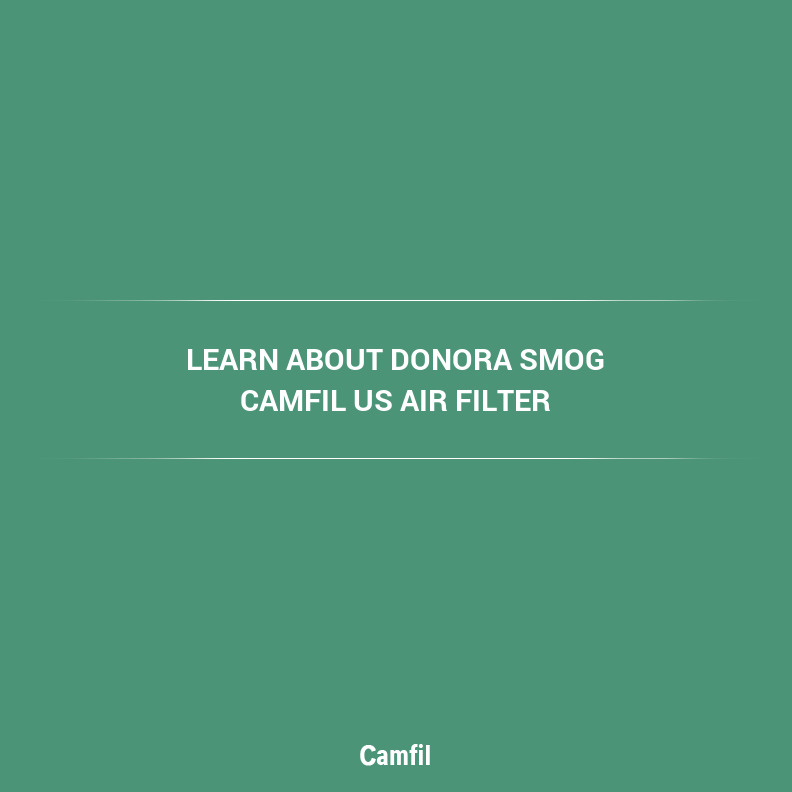Most people will have never heard of Donora, a borough in Pennsylvania that experienced one of the worst environment-related public health disasters in United States history, forcing government officials to recognize the problem of air pollution. This disaster would eventually pave the way for the Clean Air Act and awareness of the importance of air filters.
The catastrophic event, known as the 1948 Donora Smog, played a pivotal role in pushing for air quality regulations in the country. The air quality phenomenon saw the whole town exposed to extremely high levels of smog pollution, which left 27 people dead in a single weekend and twice as many in the month that followed. Hundreds of residents also fell ill, and later reports indicate that the death rate continued to remain high for another 10 years.
Scientists attributed the unusually high levels of airborne pollutants in the town that year to atmospheric inversion.
The Effect of Atmospheric Inversion on Indoor Air Quality
An atmospheric inversion is an event in which air stops circulating and is trapped close to the ground. Under normal circumstances, this phenomenon means that cool air is trapped at ground level by a higher layer of warm air. What happened in Donora, however, is that the inversion also trapped toxic gasses at ground level, causing indoor air quality in the town to plunge to dangerously poor levels.
“Indoor air quality refers to the aerosol and gas content, temperature, and humidity of the air inside a structure,” said Camfil USA’s Mark Davidson, Manager of Marketing & Technical Materials for commercial air filters and ASHRAE member and active committee participant. “In the case of human habitation, the quality of the air is determined by its ability to maintain the health and well-being of humans occupying the structure.”
And in 1948, the air in Donovan was indeed teeming with airborne pollutants.
Could Higher Efficiency Air Filters Have Prevented the Problem?
As it turns out, higher efficiency air filters could have helped save lives and protect people from airborne pollutants if they had spent most of their time indoors.
Residents recounted how during the early hours of October 26, 1948, a fog had settled over the town, which was also home to U.S. Steel Corporation’s Donora Zinc Works and American Steel and Wire. The fog became thicker in the hours that followed, so much so that witnesses remember being able to taste it.
By October 29, atmospheric inversion had trapped so much fog and pollution in the town that attendees of a local football game said they could barely see the players on the field. Recognizing the health risks posed by the smog, doctors sounded the alarm and ordered the sick and elderly to leave town right away. The doctors themselves had trouble breathing, and firefighters, who tried to provide people with oxygen, were prevented from doing so due to the poor visibility—in the middle of the day.
Finally, on October 30, Donora Zinc Works and American Steel and Wire stopped operations. The next morning the fog began to disappear, but not before leaving survivors with permanent lung damage.
Today, these events are memorialized in the Donora Smog Museum as a reminder never to take breathable air for granted.
Even Today, Air Filters with a Higher Capture Efficiency are Still Needed for the Same Problems
Unfortunately, air pollution problems exacerbated by inversion continue to happen today, highlighting the importance of air filtration systems.
In the Greater Salt Lake area, for example, the inversion is usually at its worst during January and February, when cool air, snow on the ground, and little to no wind create the perfect conditions to keep cold air from escaping the valley. These conditions happen when a high-pressure system hovers over the Wasatch Mountains and traps cold air in the valley, where it combines with pollutants from automobiles and fireplaces.
The fog that hangs over the valley transforms into smog and turns a shade of brown. But what people can’t see is that the amount of pollutants in the air when this happens already exceeds the U.S. Environmental Protection Agency’s air quality standards.
Frequent Wildfires Create the Same Problem, Creating Demand for Businesses, Hospitals and Residences to Upgrade Air Filters
The wildfires that have become more frequent in California also raise the importance of air filters for maintaining indoor air quality due to two reasons:
- First, homes and buildings near wildfires are exposed to plumes of smoke full of airborne pollutants, including toxic gasses and particulate matter.
- Second, homes and buildings located hundreds of miles away from the fires can still suffer from smoke exposure caused by the inversion.
Take the San Joaquin Valley, for example. Despite being far from the wildfires raging in the north, the valley’s topography and weather patterns have the effect of trapping pollutant-laden air that drifts into the area. Heat from the sun pushes the cool and polluted air to the ground, preventing it from escaping. Indeed, the Ferguson Fire and the Mendocino Complex Fires have dumped wildfire smoke into the valley, causing ambient air quality levels to decline rapidly.
High Efficiency Air Filters Have Never Been More Important
For cities with air quality problems exacerbated by inversion, air filters are obviously vital to the health and safety of residents. When choosing an air filter, it’s important to choose a solution from a reliable manufacturer.
At Camfil USA, we take our responsibility of protecting buildings from air pollution seriously. Talk to our team to learn about the importance of protecting indoor air quality against air pollution. You may also explore our product finder for air filters to learn more about our product line.
Media Contact:
Lynne Laake
T: 888.599.6620
E: Lynne.Laake@camfil.com
F: Friend Camfil USA on Facebook
T: Follow Camfil USA on Twitter
Y: Watch Camfil Videos on YouTube
The post What the Donora Smog Crisis Can Teach Us About the Need for Air Filters appeared first on Air Filters for Clean Air.

